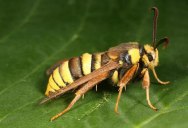To Protect Itself this Moth Looks Exactly Like a Hornet

To protect itself from would-be predators, the Hornet Moth (Sesia apiformis) has evolved to mimic the look and mannerisms of a real hornet. The large bulky moth has a typical wingspan of 33-48 mm (adults) with yellow banding on its abdomen.

The moth is as large as a hornet and even mimics the hornet’s ‘jerky flight’ when disturbed. However, the hornet moth has more yellow and lacks the waist between the abdomen and the thorax. After emergence, most of the wing scales are lost revealing the transparent wing membrane. [source]

There are several known species of the hornet moth genus (Sesia) including: Sesia bembeciformis (British Isles) smaller with black head and shoulders, Sesia melanocephala (Europe) and Sesia pimplaeformis (Europe)
Recorded habitats include parks, hedgerows, golf courses, quarries, pits, fens, plantation edges, pond edges, damp woodland and marshy areas with mature willows. The eggs are laid in old and isolated trees. Trees in open habitats with little vegetation round the base are a particular favourite. [source]

[Life cycle] It overwinters as a larva one and sometimes two times, after which it stays in its cocoon for another winter. Adults are often found on poplar trees straight after emergence. The females lay their eggs at the base of poplar trees, the larval food plant. The larva hatch and feed mainly just beneath the surface of the bark, near ground or below it.
Exit holes can often be seen near the base of poplar trees and there may be pupal cases nearby. The pupal exuvia may also be seen protruding from the exit holes on the trunk of the host tree. Adults are most active in sunshine but are seldom seen. Emergence from the pupa is in early morning and synchronous. Groups of newly emerged moths may be observed resting on the tree trunk for a few hours before flight. [source]


If you enjoyed this post, the Sifter
highly recommends:

Sign up to get our BEST stories of the week straight to your inbox.




